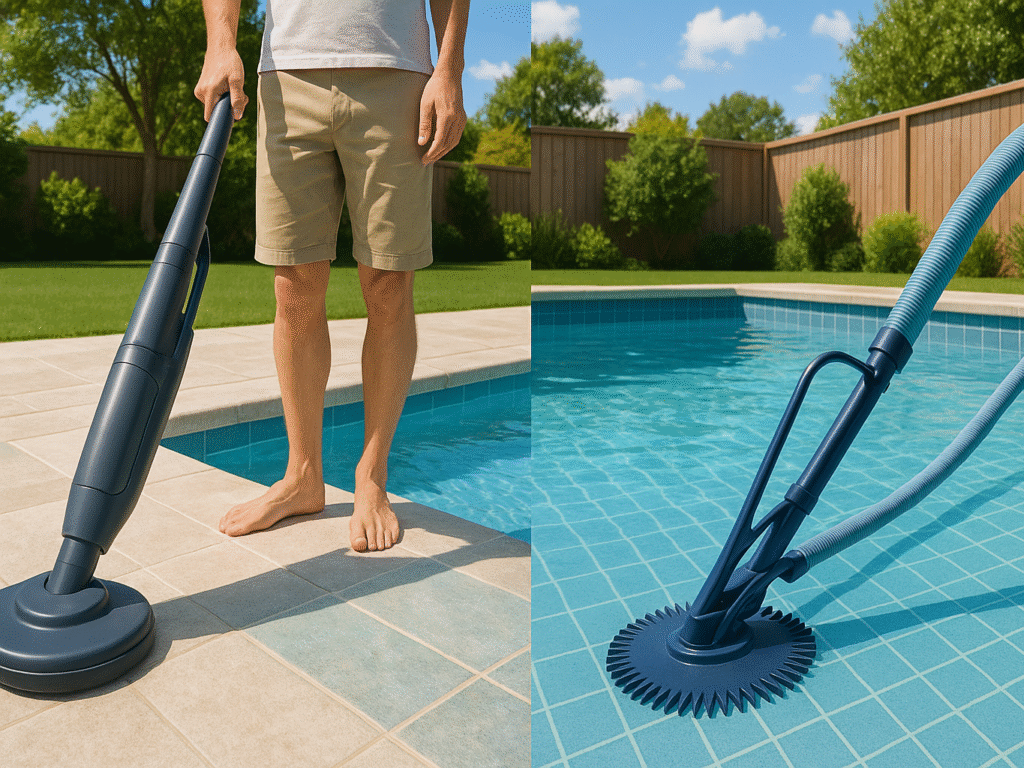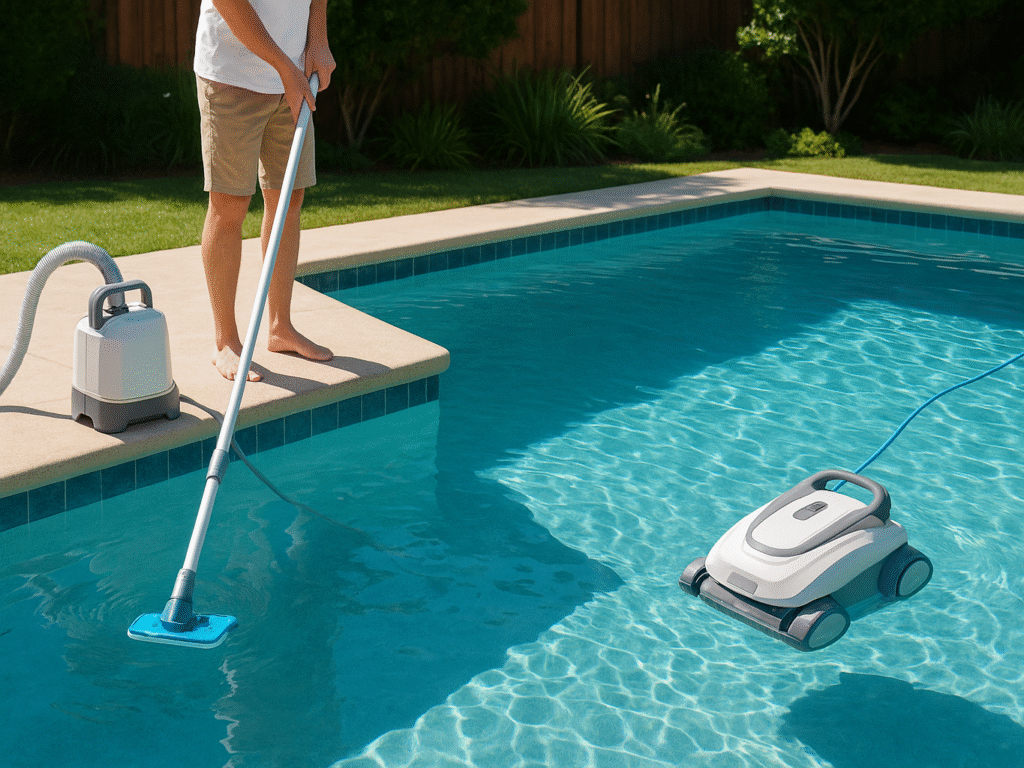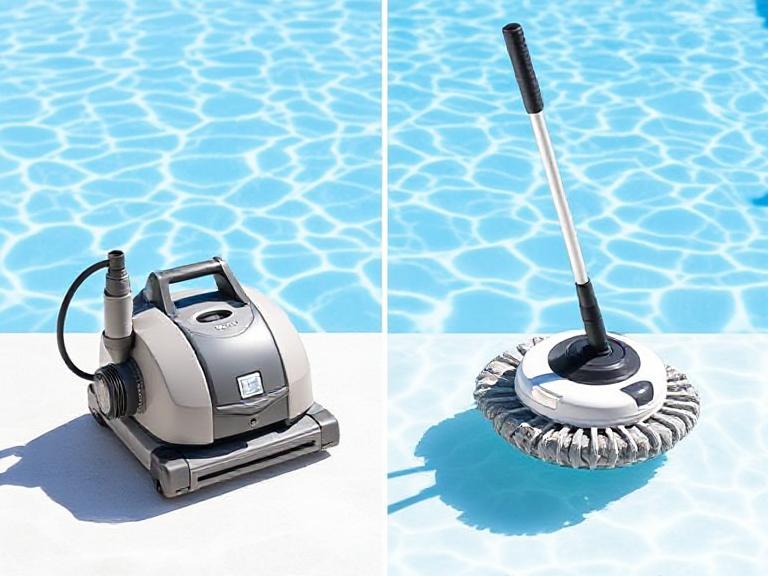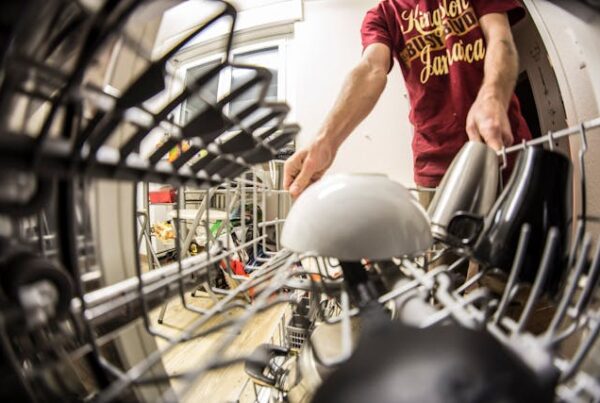Choosing the right portable pool vacuum can be challenging, as there are numerous options ranging from handheld rechargeable models to traditional cleaning systems. Whether you own a small above-ground pool or a larger inground swimming pool, finding the perfect cleaning solution impacts both your time and enjoyment.
Today’s portable swimming pool vacuums offer impressive capabilities. Professional portable pool vacuum models like the KOKIDO and Teguy provide powerful suction up to 18.5 gallons per minute, making them effective for pools up to 20 feet in size. Furthermore, the best portable pool vacuum cleaner models typically run for 45-60 minutes on a single charge, while weighing just 4 pounds, making them remarkably easy to handle. Unlike robotic cleaners, which may be better suited for larger pools of 24-28 feet, these portable options are ideal for 15-18-foot round pools, including Intex models that you set up and take down seasonally.
In this comprehensive guide, you’ll discover the key differences between portable pool vacuum pumps and traditional cleaners. We’ll examine their operation, efficiency, costs, and suitability for various pool types to help you make an informed decision tailored to your specific needs.
What is a portable pool vacuum pump?

A portable vacuum for swimming pool cleaning serves as a standalone cleaning device that can be easily moved around your swimming area. Essentially, it consists of a self-contained pump system that creates suction to remove debris and sediment from your pool with minimal setup.
How it works and what it includes
Portable pool vacuum pumps operate through a simple yet effective mechanism. The unit creates suction that pulls debris from the pool floor and walls into a collection system. Most portable vacuums include:
- A pool pump (typically 3/4HP to 1.5HP for optimal performance)
- Power cord (usually with GFCI protection)
- Hose adapters for connecting suction and discharge hoses
- Vacuum head attachment for the pool floor
The system works by drawing pool water through the vacuum head, filtering out debris, and then either returning filtered water to the pool or discharging it to waste. This “vacuum to waste” capability allows you to completely remove silt, mud, and acceptable debris from your pool.
Types of portable pool vacuum pumps
Portable pool vacuums come in several variations based on power source and design:
- Electric-Powered Vacuums: These plug-in units offer strong, consistent suction power. They’re ideal for routine maintenance of medium to large pools and generally require a standard 115V outlet. Some models include up to 100 feet of power cord with waterproof switches.
- Gas-Powered Vacuums: More powerful than electric models, these professional portable pool vacuum units are excellent for intensive cleaning tasks where electrical outlets aren’t available. Honda semi-trash pumps in the 3-5 HP range are commonly used for this purpose.
- Battery-Powered Vacuums: These cordless units offer maximum mobility without the need for cords. They’re best suited for spot cleaning or smaller pools.
- Self-Contained Systems: These all-in-one units come with their pump, filter, and hose systems, offering convenience for homeowners.
When to use a portable vacuum for a swimming pool
A portable vacuum for swimming pool maintenance is particularly valuable in specific situations:
- During initial pool openings, when heavy debris is present
- For pools without built-in cleaning systems
- When you need to vacuum directly to waste (lowering water levels)
- For cleaning areas with excessive silt, mud, or acceptable debris
- In commercial settings where a professional portable pool vacuum is needed
- When cleaning water features beyond the main pool
These devices prove especially useful for pools filled with leaves or during winterization, as they can simultaneously vacuum debris and lower water levels.
| Product Name | Price | Suction Power | Battery Life | Pool Size | Weight | Features | Amazon Link |
| KOKIDO Rechargeable Pool Vacuum | $69.00 | 10 GPM | 60 minutes | Up to 20 ft pools | 4 lbs | Aluminum pole, 2 brush heads, cordless spot cleaning | Buy on Amazon |
| Pool Vacuum for Above Ground Pool with Telescopic Pole T403 | $159.99 | 18.5 GPM | 60 minutes | Above ground pools | 5.2 lbs | Telescopic pole, powerful suction, rechargeable | Buy on Amazon |
| Teguy Cordless Pool Vacuum | $139.99 | 18.5 GPM | 90 minutes | Above/Inground pools | 4.8 lbs | Supercharge technology, telescopic pole, dual-phase cleaning | Buy on Amazon |
| Intex Pool Vacuum Cleaner | $69.99 | 12 GPM | 45 minutes | Above ground pools | 3.5 lbs | 94″ telescoping shaft, 2 brush heads, lightweight design | Buy on Amazon |
| InoKraft Pool Vacuum Cleaner | $129.99 | 16 GPM | 60 minutes | Above/Inground pools | 4.2 lbs | Transparent head, 59″ extendable pole, anti-backflow design | Buy on Amazon |
How traditional pool cleaners operate

Traditional pool cleaning systems differ from portable vacuums in both design and functionality. These established cleaning methods rely on your pool’s existing infrastructure to maintain water clarity and remove debris.
Suction-side vs pressure-side vs robotic cleaners
Suction-side cleaners connect directly to your pool’s filtration system through the skimmer or a dedicated suction line, using the pool pump’s power to move and collect debris. They excel at removing fine particles, such as sand and dirt, but struggle with larger items. Typically priced between $200 and $500, these budget-friendly options move randomly across pool surfaces.
Pressure-side cleaners, alternatively, attach to your pool’s return jets, using water pressure to propel themselves while collecting debris in separate filter bags. This design prevents clogging your primary filtration system. Although more effective with larger debris, such as leaves and sticks, they often require a booster pump that consumes 700-1000 watts of power, potentially adding several hundred dollars to annual operating costs.
Robotic cleaners represent the most advanced option, operating independently with onboard motors, filtration, and intelligent navigation systems. They require no connection to your pool’s plumbing system.
Setup and maintenance requirements
Maintaining traditional cleaners involves regular inspection of components for wear, emptying debris baskets, and checking filtration systems. Suction cleaners require frequent filter cleaning, as all collected material is directed to your pool’s primary filter.
Pressure cleaners require regular emptying of their filter bags to maintain efficiency. For longevity, store any automatic pool cleaner in a cool, dry place when not in use. Drain hoses and straighten them to prevent coiling.
Every day use cases for traditional cleaners
Suction cleaners work best in pools with minimal large debris and strong filtration systems. They’re ideal for pools experiencing primarily sand and silt issues.
Pressure cleaners excel in leaf-prone environments or pools with significant debris. Their tail component provides a consistent scrubbing action that helps maintain brilliant pool finishes over time.
Robotic cleaners are suitable for pools that require comprehensive cleaning with minimal owner intervention, although they come with higher initial costs compared to other traditional options.
Portable pool vacuum pump vs traditional cleaner: Key differences

When comparing a portable vacuum for swimming pool cleaning to conventional cleaning systems, several key differences become apparent in their functionality and the benefits they offer pool owners.
Ease of Setup and Portability
Portable pool vacuums are incredibly easy to use. Just charge or plug in the device and start cleaning. They don’t need hose connections or integration with your pool’s system, making them ideal for quick and hassle-free cleaning tasks.
- Weighs only 4–12 pounds dry, easy to lift
- No long hoses to untangle or manage
- Great for above-ground or irregular-shaped pools
Traditional cleaners often require complex setups. You must connect hoses properly and align them with the filtration system. Their long hoses may limit movement or become tangled, slowing down the process and making them less convenient for casual or first-time users.
Cleaning Power and Efficiency
Traditional cleaners often deliver more powerful suction because they use the pool’s pump system. It makes them ideal for regular cleaning of large debris fields and consistent maintenance across medium to large-sized pools with frequent use.
However, portable vacuums excel at precision tasks. They’re great for spot-cleaning, targeting debris buildup in specific areas. Some models also feature smart navigation, enabling more efficient coverage compared to older, traditional models with random patterns.
Battery Life vs Continuous Operation
Cordless portable vacuums generally last between 60 and 120 minutes per charge. They are best suited for small pools or quick cleaning sessions. Once the battery runs out, you’ll need to recharge before subsequent use.
- Battery-powered for cordless freedom
- Perfect for routine spot treatments
- Most models recharge within 4–6 hours
In contrast, traditional cleaners operate as long as the pump is running. It means they can clean continuously for several hours, which is helpful for large pools, but adds significantly to your energy bill and wears down your pump system faster.
Cost and Long-Term Value
Portable vacuum units usually cost between $500- $1500 upfront. While more expensive initially, they save on operating costs. With less stress on your pool’s system, portable vacuums require fewer repairs and generally have lower energy use.
- Portable units cost $50–$100 yearly to run
- Traditional cleaners may cost $300–$500 annually
- Reduced wear on pumps and filters saves on maintenance
Traditional cleaners range from $200 to $500, but often lead to higher long-term expenses. Since they rely on your pool’s pump and filter, you may experience increased energy consumption and accelerated equipment wear, especially with daily or prolonged use.
Storage and Space Considerations
Portable vacuums are compact and self-contained, making them easy to store without occupying much space. After use, they can be quickly removed and stored on a shelf or in a cabinet without disassembly or draining hoses.
Traditional systems require more effort. Their bulky hoses and connection equipment require careful handling and additional storage space. Leaving them in the pool year-round may save time, but it also increases wear, leading to faster replacements or repair needs.
Pros and cons of each option
Evaluating swimming pool cleaning options requires understanding the strengths and limitations of each approach. Both portable vacuum pumps and traditional cleaners have distinct advantages for different situations.
Pros of portable pool vacuum pumps
A portable vacuum for swimming pool cleaning operates independently from your pool’s filtration system, consequently reducing strain on your existing equipment. These units excel at targeted cleaning, allowing you to address specific problem areas rather than waiting for an automatic cleaner to reach them.
The self-contained filtration system captures debris separately, minimizing the need for backwashing and conserving water. Notably, portable vacuums are lightweight and easy to handle, making maintenance substantially simpler. They’re particularly valuable for cleaning up after storms or handling excessive debris that might overwhelm a traditional system.
Cons of portable pool vacuum pumps
Most cordless portable vacuums have limited run times, typically just 1-2 hours, which isn’t sufficient for larger pools. These units require regular recharging between uses. Primarily due to battery constraints, cordless models typically have smaller motors and less suction power than their corded counterparts. The initial investment for a professional portable pool vacuum system can be substantial, with prices ranging from $500 to $1,500.
Pros of traditional pool cleaners
Traditional cleaners offer a more budget-friendly entry point, with suction-side cleaners typically priced between $200 and $500. These systems can provide continuous operation as long as your pool pump runs. Pressure-side cleaners excel at collecting larger debris, such as leaves and twigs. Many robotic models feature innovative navigation systems that methodically clean your entire pool surface.
Cons of traditional pool cleaners
Traditional cleaners increase the workload on your pool’s pump and filtration system. They typically require a more complex installation with proper hose connections.
The energy costs can be substantial; running a booster pump for pressure-side cleaners can add several hundred dollars to annual operating expenses. Most suction and pressure cleaners lack smart navigation, often missing spots or repeatedly cleaning the same areas.
Which is better for small pools?
For smaller pools, the best portable pool vacuum cleaner models offer ideal functionality. Their compact design and targeted cleaning capabilities make them perfect for above-ground pools and smaller in-ground pools. The lightweight nature (approximately 4 pounds when dry) makes them easy to maneuver in limited spaces.
Which is better for large or in-ground pools?
Large or in-ground pools benefit most from robotic traditional cleaners. These models can cover expansive areas up to 50 feet in length. With commercial-grade motors and advanced filtration, high-end traditional cleaners provide the sustained power needed for larger volumes of water. Their ability to climb walls and scrub the waterline ensures comprehensive cleaning of larger spaces.
Conclusion

Choosing between a portable pool vacuum pump and a traditional cleaner depends on the size of your pool, the level of debris, and your usage habits. The best portable pool vacuum cleaner models are independent, user-friendly, and perfect for quick cleanups. They excel in small or above-ground pools and during post-storm maintenance when fast, targeted cleaning is essential.
Traditional cleaners operate using your pool’s built-in system and typically come at a lower initial cost. Suction-side and pressure-side cleaners work continuously, while robotic versions offer smart navigation and deep cleaning. They’re ideal for larger pools that require full coverage and benefit from automation, although they may increase utility costs over time.
Portable vacuums cost more upfront, typically ranging from $500 to $ 1,500, but often save money in the long term through reduced energy use. Traditional models, although cheaper initially, may incur higher maintenance and electricity costs. The right choice balances your budget, pool size, and cleaning frequency, ensuring your pool stays clean without complicating your routine.
FAQs on Portable pool vacuum
1. What are the key benefits of portable pool vacuum pumps?
Portable pool vacuums reduce the load on your primary filtration system. They’re lightweight, self-contained, and excellent for spot cleaning. Ideal for storm debris or algae, they provide flexibility and are easy to use in hard-to-reach areas.
2. How do traditional pool cleaners differ in operation?
Traditional cleaners rely on the pool’s filtration system. Suction-side units use the skimmer, while pressure-side ones connect to return jets. Robotic cleaners, however, run independently with built-in motors and filters, reducing strain on your pool equipment.
3. What is the best pool cleaner for small pools?
Portable vacuum pumps are great for small or above-ground pools. They’re compact, easy to carry, and don’t depend on your pool system. Their precision cleaning and simple setup make them perfect for tight or shallow pool spaces.
4. What are the cost differences between portable and traditional cleaners?
Portable vacuums cost $500–$1500 upfront but save on energy. Traditional cleaners are initially cheaper, at $200–$500, but can increase electricity bills by $300–$500 per year due to pump strain and longer cleaning cycles.



